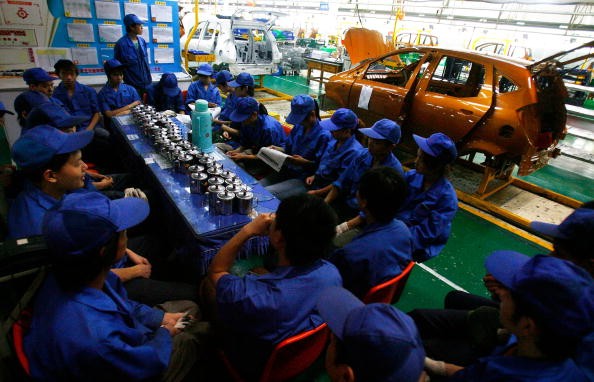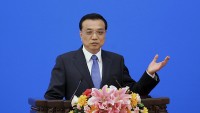China to Develop More Industrial Parks to Spur Socio-Economic Growth
| Garima Vohra | | Jul 10, 2015 11:35 AM EDT |
(Photo : Getty Images) Workers take a break from the production line of Chang'an Benben at the Chang'an Industrial Park, a production facility of Chang'an Automobile May 16, 2007 in Chongqing Municipality, China.
In a bid to drive the economy at a desired rate, China has decided to develop approximately 60 zones to promote industrial urbanization.
Though there are no available specifications in the selected areas, they will be designed on the same lines as the existing national industrial parks.
Like Us on Facebook
The National Development and Reform Commission (NDRC) said driving industrial urbanization will help in transforming the country's industrial parks comprehensively. This will in turn drive the economy as well as urbanization.
Prime Minister Li Kequiang considers urbanization as a gigantic engine, which is critical for the economic success of China.
In 1980, four Special Economic Zones (SEZs) were created before the industrial parks came into being. They were located in Shenzhen, Zhuhai, as well as Shantou in Guangdong Province, and the fourth SEZ was located in the city of Xiamen. They were known as Open Coastal Cities and were in proximity to Hong Kong, Macao, and Taiwan - the world's major business centers.
A few years later, 14 national industrial parks were created. They are also known as the Economic and Technological Development Zones. These different industrial zones were created as a part of the Open Door Policy of China launched in 1978.
These SEZs and industrial parks are dedicated zones for exporting manufactured goods. They are built over a large area of land with wide streets, bridges, sewer lines, water facility, power stations, and residential space. In short, industrial parks are small cities that can accommodate several companies and their employees. Since these SEZs and industrial parks have proven to give impetus to China's growth and economy, the 60 new zones will be based on the existing SEZs and industrial parks.
According to the Blue Book released by the Chinese Academy of Social Sciences in 2013, the rate of urbanization in China will reach 60 percent by 2018, and the NDRC has predicted that more people will shift to these zones by 2020 as they will grow faster than the other areas because of the socio-economic development there.
TagsOpen Door Policy of China, Urbanization in China, China's Industrial Parks, China's economic growth, National Development and Reform Commission, Chinese Academy of Social Sciences
©2015 Chinatopix All rights reserved. Do not reproduce without permission
EDITOR'S PICKS
-

Did the Trump administration just announce plans for a trade war with ‘hostile’ China and Russia?
-

US Senate passes Taiwan travel bill slammed by China
-

As Yan Sihong’s family grieves, here are other Chinese students who went missing abroad. Some have never been found
-

Beijing blasts Western critics who ‘smear China’ with the term sharp power
-

China Envoy Seeks to Defuse Tensions With U.S. as a Trade War Brews
-

Singapore's Deputy PM Provides Bitcoin Vote of Confidence Amid China's Blanket Bans
-

China warns investors over risks in overseas virtual currency trading
-

Chinese government most trustworthy: survey
-

Kashima Antlers On Course For Back-To-Back Titles
MOST POPULAR
LATEST NEWS
Zhou Yongkang: China's Former Security Chief Sentenced to Life in Prison

China's former Chief of the Ministry of Public Security, Zhou Yongkang, has been given a life sentence after he was found guilty of abusing his office, bribery and deliberately ... Full Article
TRENDING STORY

China Pork Prices Expected to Stabilize As The Supplies Recover

Elephone P9000 Smartphone is now on Sale on Amazon India

There's a Big Chance Cliffhangers Won't Still Be Resolved When Grey's Anatomy Season 13 Returns

Supreme Court Ruled on Samsung vs Apple Dispute for Patent Infringement

Microsoft Surface Pro 5 Rumors and Release Date: What is the Latest?













